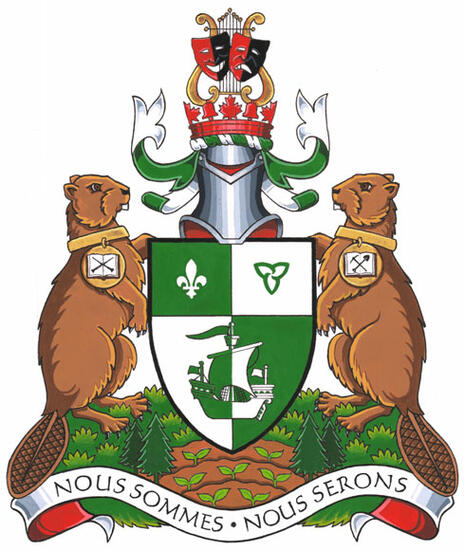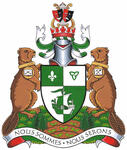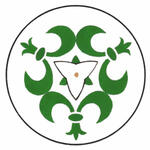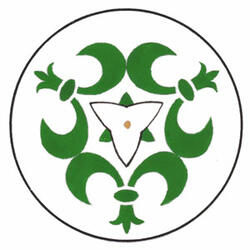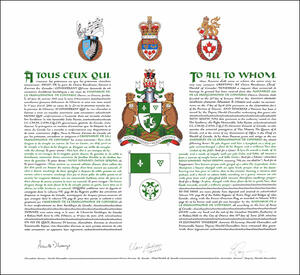The contents of this Register are intended for research purposes only. The heraldic emblems found in the Register may not be reproduced in any form or in any media without the written consent of the Canadian Heraldic Authority and/or the recipient.
Ottawa, Ontario
Grant of Arms, Supporters and Badge
June 15, 2018
Vol. VII, p. 88
Arms of the Assemblée de la francophonie de l’OntarioBlazonPer pale Argent and Vert a lymphad, on a chief per pale counterchanged a fleur-de-lis Argent and a trillium Vert voided of the field; SymbolismThe ship, a reference to that used by Samuel de Champlain, the first European explorer in the Pays d’en haut (New France’s Upper Country, roughly today’s Ontario), represents the migrations and by extension the various origins of French-speaking Ontarians, as well as their courage and determination. The Franco-Ontarian flag in the upper section uses a fleur-de-lis, a symbol of Francophone pride, and a trillium, the floral emblem of Ontario. The colours represent the white of Ontario’s winters and the green of its summers. |
CrestBlazonA lyre Or overall a mask of comedy and a mask of tragedy each per pale Gules and Sable, all issuant from a coronet of maple leaves and bells Gules; SymbolismThe lyre and the masks pay tribute to Franco-Ontarian culture. The maple leaves indicate the contributions to and pride in Canada of Franco-Ontarians. The bells, symbolic of summoning, underline the advocacy role played by the Assemblée de la francophonie de l’Ontario (AFO). |
MottoBlazonNOUS SOMMES • NOUS SERONS; SymbolismThis phrase meaning “We are, we shall be” was the rallying cry since the 1970s of the Association canadienne-française de l’Ontario, the body that later became the AFO. |
SupportersBlazonTwo beavers proper each gorged of a collar Or pendent therefrom a bezant charged with an open book proper, that to the dexter bearing two hat pins in saltire, that to the sinister bearing a miner’s pickaxe and a shovel in saltire Sable, standing on a grassy mount set with pine trees and a ploughed field issuant therefrom seedlings proper; SymbolismThe beaver is the emblem of the fur trade and thus of the exploration of Ontario. The books express the importance of education as well as the rich heritage of Franco-Ontarian literature. The hat pins recall the struggle against Regulation 17, which forbade the use of French as a teaching language in Ontario schools from 1912 to 1927, as the mothers of Francophone students used hat pins to protect teachers defying the authorities during a famous incident at Guigues School in Ottawa, in 1916. The miner’s pick and the shovel honour the pioneers who helped discover and develop the mining and agricultural riches of the province. The pine trees and the cultivated ground refer to the natural resources of the land and the entrepreneurial spirit of its inhabitants. |
Additional InformationCreator(s)Original concept of the Assemblée de la francophonie de l’Ontario and Samy Khalid, Saguenay Herald, assisted by the heralds of the Canadian Heraldic Authority. PainterRobert Grey CalligrapherLuc Saucier Recipient TypeCivil Institution |

